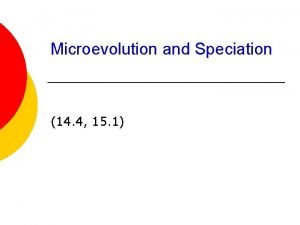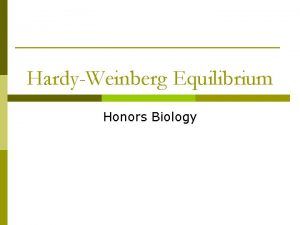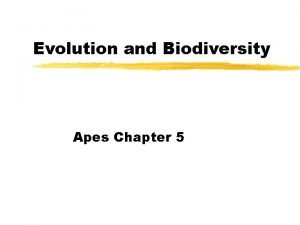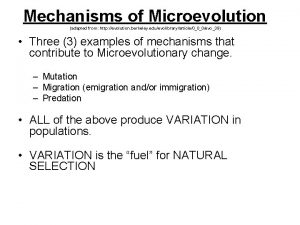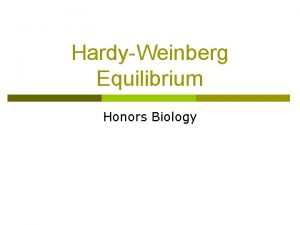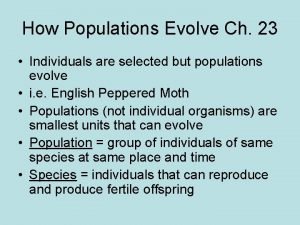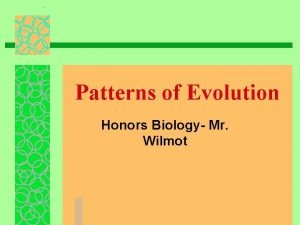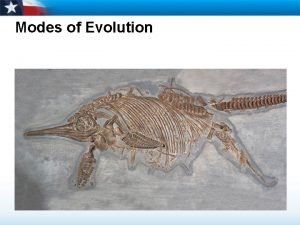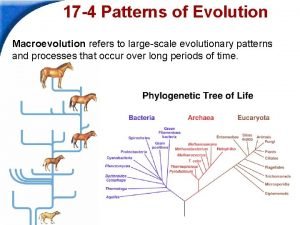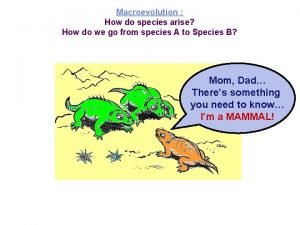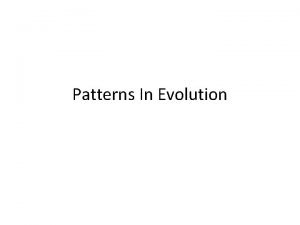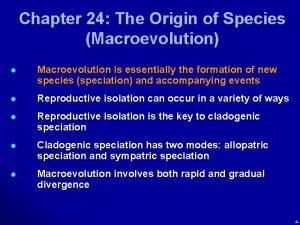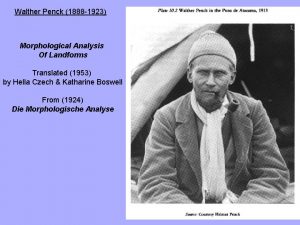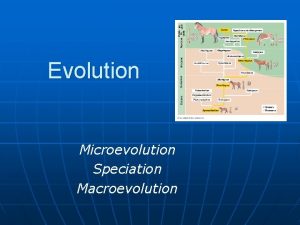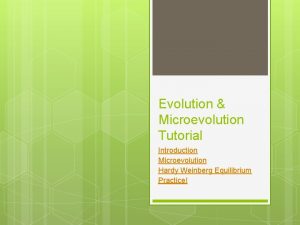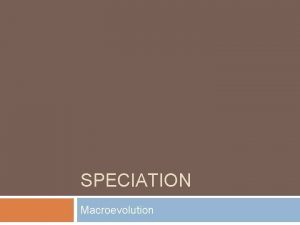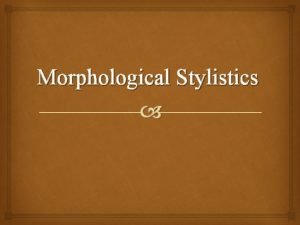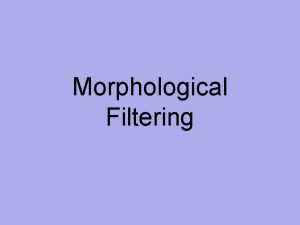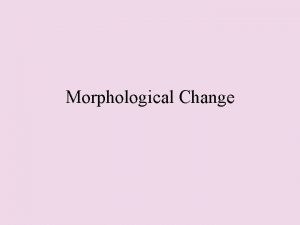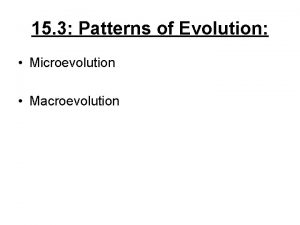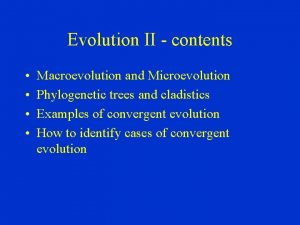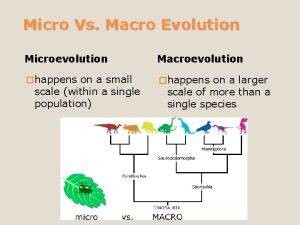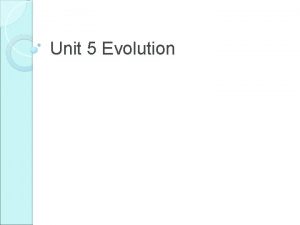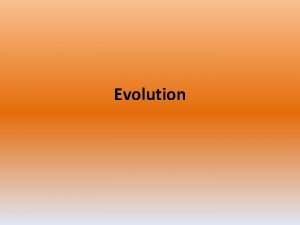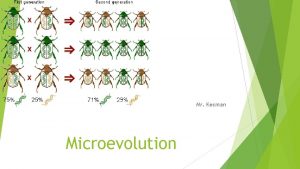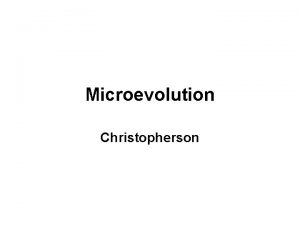Lecture 20 Morphological Changes in Macroevolution Microevolution evolution

















- Slides: 17

Lecture 20: Morphological Changes in Macroevolution • Microevolution = evolution w/i species • Macroevolution = evolution at or above sp. level Macroevolution: often major morph changes How do they occur? • Saltation: new features arise by major reorgan’n not progression through intermediates Punctuated equilibrium ( no specific mech. ) Darwin was an anti-Saltationist

Morphological Changes Completely new features rare: • usually modification of ancestral feature • e. g. branchial basket (agnathans) gill arch (bony fish) jaw (reptile) ear bones (mammal) (N. B. not direct descendants, C. A. )

Transformation Changes in elements: number size shape position association with other parts differentiation (complexity)

Examples • Enlargement of Cerebral Hemispheres (reptile mammal) • Complexity of Lung ( amphib rept mamm) • Reduction of skull bones ( fish mamm)

Serially Homologous Features: e. g. petals, scales, stamens, digits etc. • May increase in number: (vertebrae in snakes; body segments in millipedes) • More frequently reduced: (teeth, vertebrae, digits in most vertebrate lineages)

Serially Homologous Structures • change more likely when indeterminate (large #, variable) • e. g. stamens ( magnolias vs. legumes)

• Differentiation of structures from ancestor: e. g. leaves tendrils; spines etc. e. g. appendages of trilobites mouthparts, reproductive, locomotary • Structures may become homogeneous e. g. toothed whales

Allometry : • differential rates of growth of body parts • comparisons may be inter- or intraspecific • intraspecific : w/i inds (ontogenetic - different ages) among inds (static - same age)

Allometry Equation: y = b xa Linearized: log y = log b + a log x • e. g. ontogenetic allometry Humans Black-headed Godwits

Adaptiveness of Allometry • e. g. intestine scales 3/2 body size i. e. intestine length = body size 1. 5 • b/c surface area : volume ratio

Interspecific Allometry of brain: body weight: • Homeotherms: Brw = 0. 07 (Bw)0. 67 • Poikilotherms: Brw = 0. 007 (Bw)0. 67

Heterochrony brain wt Evolutionary changes in timing of dev’t of feature e. g. compare ontogeny of 2 spp. : sp 2 sp 1 body wt Brain size changes faster (rel. to body) in sp. 2 vs. sp. 1 Brain cell lines in sp. 2 develop faster than in sp. 1

Types of Heterochrony 1) Peramorphosis: add’n of extra stages beyond adult stage of ancestor a) Hypermorphosis: more stages, longer time b) Acceleration: more stages, same time c) Predisplacement: starts earlier

Types of Heterochrony 2) Paedomorphosis : retention of juvenile features in adult (opposite of peramorphosis) a) Progenesis : development stops early b) Neoteny : development slowed c) Postdisplacement : starts late

Growth curves line of equal growth (m=1) log y ancestral trajectory: = starts growing = stops growing log x slope > 1 y grows fast relative to x

Hypermorphosis • Type of peramorphosis: • growth of structure lasts longer during dev’t • greater y/x ratio at maturity rel. to ancestor 1 extended dev’t log y m= 1 log x = ancestral cond’n 1 = descendant cond’n

Irish Elk • e. g. of Hypermorphosis • extinct ~ 10, 000 years ago • antlers: 13 ft span ~ 100 lb! • metabolic costs of antler prod’n • implicated in extinction: • to grow 40 kg antlers in 150 days : 60 g calcium; 30 g phosphorus per day!
 Microevolution
Microevolution Microevolution
Microevolution Microevolution
Microevolution 3 mechanisms of microevolution
3 mechanisms of microevolution Microevolution
Microevolution Agents of microevolution
Agents of microevolution Macroevolution 7 patterns
Macroevolution 7 patterns New concept chapter 19
New concept chapter 19 Macroevolution definition
Macroevolution definition Connecting the concepts macroevolution
Connecting the concepts macroevolution Connecting the concepts: macroevolution
Connecting the concepts: macroevolution What are the two major patterns of evolution?
What are the two major patterns of evolution? Cladogenic
Cladogenic Changes in latitudes, changes in attitudes meaning
Changes in latitudes, changes in attitudes meaning Chemical change examples pictures
Chemical change examples pictures 01:640:244 lecture notes - lecture 15: plat, idah, farad
01:640:244 lecture notes - lecture 15: plat, idah, farad Walther penck
Walther penck Types of meaning
Types of meaning
